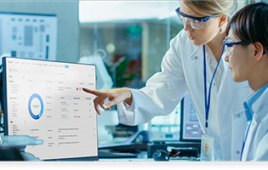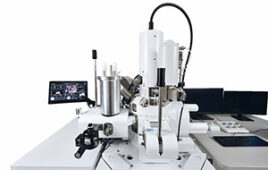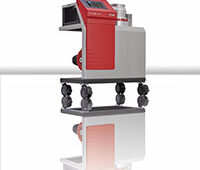By Neal Reid

A team of Auburn University physics students is working with Associate Professor of Physics Guillaume Laurent in the Auburn Source of Attosecond Pulses, or ASAP, Laboratory to study and manipulate atoms and molecules using high-speed pulsed lasers.
When it comes to world-class equipment, laboratories at Auburn University’s College of Sciences and Mathematics, or COSAM, are in a league of their own.
COSAM’s facilities have all the cutting-edge technology, innovative hardware and state-of-the-art equipment that allows for both fundamental examination and practical application. Armed with a litany of impressive tools, Auburn’s researchers — both professors and students in COSAM’s five departments — are making an impact and doing their part to advance science in the process.
One prime example is Guillaume Laurent’s Auburn Source of Attosecond Pulses, or ASAP, Laboratory, which houses instruments that help with the development of novel sources of an attosecond pulse of light. One attosecond equals 10-18 sec — the equivalent of what one second is to about 31.71 billion years.
The backbone instrument for this research program is the ultra-short femtosecond (10-15 sec) pulsed laser system, a revolutionary addition to the lab in 2016 that has allowed Laurent and his team of nearly 10 researchers to generate such attosecond pulses and use them to study and manipulate atoms and molecules.
“This femtosecond laser is a very, very intense laser, and the instantaneous energy it produces is equivalent to the energy produced by 50 nuclear plants,” said Laurent, an associate professor of physics who joined the department in 2015 after a stint at the Massachusetts Institute of Technology, or MIT. “It gives a new dimension to our group and the physics department. In the United States, there are only five or six laboratories that have developed this attosecond technology.”
Laurent and his team are excited to work in the relatively new attosecond science realm, propelled by more than $2.5 million in grants from the U.S. Department of Energy’s Office of Science and United States Air Force Office of Science Research, or AFOSR, and steadfast support from COSAM management and the Office of the Provost.
“Why this is a very big achievement for Auburn is because the equipment is something that attracts talented people to work with it,” Laurent said. “[COSAM Dean] Nick Giordano has been very supportive, and I need to thank him for that. By jumping into this big research field, a big state university like Auburn is sending a very strong message.
“I think it was a very ambitious and positive move by the college, and there are not a lot of universities that are doing that. We are leaders among the state universities.”
Using the state-of-the-art laser system to manipulate and move electrons in matter, Laurent’s team is able to learn more about numerous aspects of science.
“It’s the shortest pulse of light that’s been produced on Earth,” said Laurent, who believes that a Nobel Prize will come out of the field in the future. “Attosecond pulses of light are very important because those short bursts give you the ability to probe the motion of the electrons, and that’s important because everything in nature is controlled by electron motion. If you control electron motion, you control chemistry, and if you can control chemistry, you can control material science. If you have control of material science, you have control over technology.”
The potential practical applications that could arise from advances in attosecond science study, Laurent says, are endless.
“It’s extremely ambitious, but the goal of attosecond science is to have the ability to do things we cannot do currently,” he said. “We are still trying to find and identify the mechanisms to control this electron motion. I’m not going to be the one who suddenly has brand-new technology. In physics, when we have established the fundamental law, it moves to the engineering state where people start to do something useful with it.
“The boundaries of the consequences of this field are just limited by our imagination.”
A positive byproduct of the increasing status of the world-class lab is the ability for educators like Laurent to train the next generation of scientists — who come to Auburn from all corners of the country — while giving them a creative outlet and potentially a career in the field.
“Our main contribution is education, and I’m very proud to see that some students who have no knowledge about attosecond science and lasers in general are getting that experience and getting jobs that they would have had no chance to get without it,” he said. “This gives students a very high-tech playground, and it’s a very good step for them. We are training the next generation, and it’s advancing science.”
Laurent has an even bolder view about how attosecond science might influence other subsets of physics, namely, quantum physics or nuclear physics.
“There is a very interesting fundamental application to say that all the scientists who developed quantum physics in the early 20th century may not have been entirely correct,” Laurent said. “So, there could be a big revolution in conception in the microscopic world. In addition, attosecond science is a milestone toward even shorter light pulses, namely zeptosecond pulses, which would allow for probing and controlling nuclear reactions. These zepto-pulses could allow us to revisit the entirety of nuclear physics, with huge potential consequences because a large part of the energy we have right now—20 percent of the total electricity generated in the U.S. — comes from nuclear physics.
“If you can control nuclear reactions without having waste, imagine the potential. I’m not saying it’s going to happen, but if we can manipulate this nuclear reaction and have a pulse short and intense enough to liberate this energy without waste, we’ll have endless clean energy. So, the nuclear physicists are waiting for us.”
Studying water contaminants like never before
For Ann Ojeda, an assistant professor in the Department of Geosciences, a recently overhauled Auburn Contaminants Lab at Beard-Eaves Memorial Coliseum has given a boost to her research group in its quest to study water quality and contamination. Construction on the lab facility began in September and concluded in March, and Ojeda’s team already is hard at work putting it to use.
“My research helps to understand sources of organic contamination in water systems and the interactions that occur between contaminants and the environment,” said Ojeda, who joined the Auburn faculty last year after completing a postdoctoral fellowship at the University of Toronto. “If we understand these processes, we can better understand and mitigate threats to water resources from things like oil and chemical spills or sewage discharges.”
The lab features equipment to prepare environmental samples for analysis and a variety of instruments to measure the concentration and molecular characteristics of organic material in the samples. The renovated space houses instruments used to identify organic compounds in water and sediment at low concentrations in the environment.
“We have a gas chromatograph mass spectrometer to determine the concentration and structure of compounds, as well a high-performance liquid chromatograph with fluorescence and variable wave detectors to capture macromolecular features of dissolved organic matter,” Ojeda said. “We typically use the laboratory experiments to constrain different pathways and processes then take measurements in the field and try to reconstruct the processes acting on the contaminants. We perform laboratory experiments to simulate environmental processes or interactions and then measure the effect on the concentration and chemical features of the contaminants.”
By utilizing the state-of-the-art equipment, Ojeda’s team hopes to take its research to a new level and potentially make discoveries that can have a real-world impact.
“The lab elevates research opportunities for students and faculty to study the fate of toxic compounds in the environment and added a strong environmental research aspect to the Department of Geoscience here at Auburn,” Ojeda said. “We have also established collaborations with other faculty across the university to study topics like human impacts on water quality, advanced techniques for bioremediation of organic contaminants, the Earth’s past climate and driving forces for climate change.”
In addition to making advancements in the source, fate and transport of water contaminants, Ojeda hopes to use her lab and its ideals to inspire students of all kinds to grow into passionate, experienced scientists.
“The ultimate goal is for our group members to develop the mindset, skills and habits of scientific inquiry,” she said. “The Contaminants Lab Tenets describe some of these values, and we spend time discussing them as a team. The tenets touch on things like the importance of evidence-based reasoning, ethical practices and community engagement. The tenets are evolving as we bring new members on board with diverse experiences and expectations of research.
“For example, an undergraduate lab member has a very different end goal compared to a postdoctoral fellow or graduate student. Even so, these tenets apply equally and are the unifying theme for all our efforts. As an educator, I’m most proud to see students embrace the tenets and develop a sense of scientific independence.”





Tell Us What You Think!